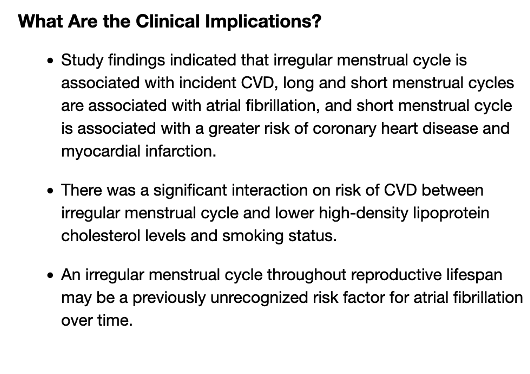| |
Associations of Menstrual Cycle Regularity and Length With Cardiovascular Diseases: A Prospective Study From UK Biobank
|
| |
| |
Download the PDF here -
24 May 2023
In this large‐scale prospective study with a median 11.8‐year follow‐up time, we found that irregular menstrual cycles were associated with increased risks of CVD independent of risk factors, including age, race and ethnicity, BMI, smoking status, drinking status, physical activity, history of oral contraceptive use, history of HRT, age at menarche, parity, baseline cholesterol levels, history of hypertension and diabetes, family history of CVD and stroke, and other confounding factors. Furthermore, long menstrual cycle length was associated with increased risks of atrial fibrillation but not myocardial infarction, heart failure, and stroke. Short menstrual cycle length was associated with a greater risk of CHD and myocardial infarction. In addition, we found the significant interaction on risk of CVD between irregular menstrual cycles and lower HDL‐C levels and smoking status. These findings have important public health implications for the prevention of CVD in women.
Abstract
Background
The association between menstrual cycle characteristics and cardiovascular outcomes remains unclear. This study was undertaken to evaluate whether menstrual cycle regularity and length throughout the life course are associated with cardiovascular outcomes.
Methods and Results
This cohort study included 58 056 women who had no cardiovascular disease (CVD) at baseline and reported their menstrual cycle regularity and length. Hazard ratios (HRs) and 95% CIs for CVD events were estimated using Cox proportional hazards models. During the median 11.8 years of follow‐up, 1623 incident CVD cases were documented, including 827 incident cases of coronary heart disease, 199 myocardial infarctions, 271 strokes, 174 cases of heart failure, and 393 cases of atrial fibrillations. Compared with women with regular menstrual cycles, the HRs for women with irregular menstrual cycles were 1.19 (95% CI, 1.07-1.31) for CVD events and 1.40 (95% CI, 1.14-1.72) for atrial fibrillation. The multivariable‐adjusted HRs for short (≤21 days) or long (35 days) menstrual cycles during follow‐up were 1.29 (95% CI, 1.11-1.50) and 1.11 (95% CI, 0.98-1.56) for CVD events, respectively. Similarly, long or short cycle length were more likely to be associated with increased risk of atrial fibrillation (HR, 1.30 [95% CI, 1.01-1.66]; and HR, 1.38 [95% CI, 1.02-1.87]), and short cycle length was more likely to be associated with increased risk of coronary heart disease and myocardial infarction. However, these associations for stroke and heart failure were not significant.
Conclusions
Long or short menstrual cycle length was associated with increased risks of CVD and atrial fibrillation but not myocardial infarction, heart failure, or stroke. Short cycle length was associated with a greater risk of coronary heart disease and myocardial infarction.

|
|
| |
| |
|
|
|